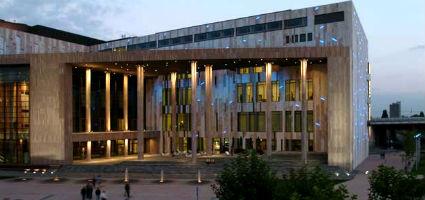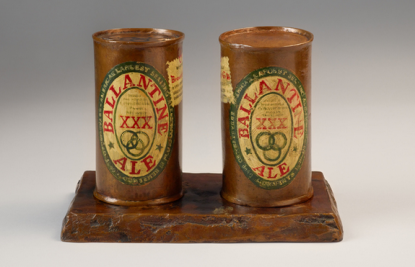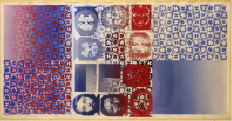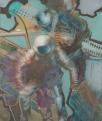2024. April 25. Thursday
Ludwig Museum - Museum of Contemporary Art - Budapest
 |
Address: 1095, Budapest Művészetek Palotája, Komor Marcell u. 1.
Phone number: (1) 555-3444, (1) 555-3457
E-mail: info@ludwigmuseum.hu
Opening hours: Permanent exhibition: Tue-Sun 10-18
Temporary exhibition: Tue-Sun 10-20 |
The exhibition has closed for visitors.
2015.10.09. - 2016.01.03.
Museum tickets, service costs:
|
Group ticket
(over 20 people 20% discount)
|
1000 HUF
|
|
|
Ticket for adults
(valid for the temporal exhibitions)
|
1200 HUF
|
|
|
Ticket for students
(valid for the temporal exhibitions)
|
600 HUF
|
|
|
Ticket for pensioners
(valid for the temporal exhibitions)
|
600 HUF
|
|
|
Ticket for families
(1 parent + max. 4 children)
|
1600 HUF
|
/ family
|
|
Ticket for families
(2 parents + max. 4 children)
|
2400 HUF
|
/ family
|
|
Ticket for adults
|
960 HUF
|
|
|
Ticket for students
|
480 HUF
|
|
|
Program ticket
|
600 HUF
|
|
|
Guide
|
4000 HUF
|
|
|
Guide
|
5000 HUF
|
The art collection brought together by Peter and Irene Ludwig is the foundation of all Ludwig Museums. Perhaps the most well-known and famous part of this collection is the body of artworks that represents the period of Pop Art. It is unique in the sense that in addition to the iconic works of the most well-known Pop artists (Jasper Johns, Roy Lichtenstein, Claes Oldenburg, Robert Rauschenberg, Andy Warhol, Tom Wesselmann, etc.), it comprises pieces by less famous ones (Allan D’Arcangelo, Richard Linder, etc.), along with artworks by the European representatives of this tendency (Peter Blake, Richard Hamilton, David Hockney, Mimmo Rotella). The collection of the Ludwig Museums alone is abundant for creating a survey exhibition of international Pop Art.

The allure of Pop Art lies in the fact – made evident by this exhibition – that succeeding the abstract tendencies, which had kept a considerable distance from the audience, it reintroduced a kind of figurative representation into the contemporary art of the time, which, owing to its everyday references, was familiar and seemingly easy to interpret for the publics. At the same time, paradoxically, these works provide a critique of consumer society by translating the mechanism of daily consumption into art, offering the artworks (i.e. consumer products) to the spectators. This is also true of representations that already criticize a specific subject, such as the (Vietam) war, the representational modes in mass media, the iconization of the brand logos of consumer goods, etc.
The exhibition Ludwig Goes Pop is partly realized as a collaboration of the Ludwig Museums; prior to the Budapest show, it was on display at the Ludwig Museums of Cologne and then Vienna. In the Budapest version, the exhibition is complemented with works by Hungarian and East-European artists (Gyula Konkoly, László Lakner, Ludmil Siskov, Boris Bućan, Tomislav Gotovac, Dušan Otašević, Stano Filko, Julius Koller, Marko Pogačnik, etc.). On the one hand, these pieces are based on the use of everyday objects in the period, and on the other hand, they provide a line-up of local cultural references. Indirectly, the exhibition also explores how the notions of “Western” art history can be interpreted in a context where the social and cultural conditions for the emergence of this tendency were fundamentally different from the original scenes where Pop Art had been created.

The allure of Pop Art lies in the fact – made evident by this exhibition – that succeeding the abstract tendencies, which had kept a considerable distance from the audience, it reintroduced a kind of figurative representation into the contemporary art of the time, which, owing to its everyday references, was familiar and seemingly easy to interpret for the publics. At the same time, paradoxically, these works provide a critique of consumer society by translating the mechanism of daily consumption into art, offering the artworks (i.e. consumer products) to the spectators. This is also true of representations that already criticize a specific subject, such as the (Vietam) war, the representational modes in mass media, the iconization of the brand logos of consumer goods, etc.
The exhibition Ludwig Goes Pop is partly realized as a collaboration of the Ludwig Museums; prior to the Budapest show, it was on display at the Ludwig Museums of Cologne and then Vienna. In the Budapest version, the exhibition is complemented with works by Hungarian and East-European artists (Gyula Konkoly, László Lakner, Ludmil Siskov, Boris Bućan, Tomislav Gotovac, Dušan Otašević, Stano Filko, Julius Koller, Marko Pogačnik, etc.). On the one hand, these pieces are based on the use of everyday objects in the period, and on the other hand, they provide a line-up of local cultural references. Indirectly, the exhibition also explores how the notions of “Western” art history can be interpreted in a context where the social and cultural conditions for the emergence of this tendency were fundamentally different from the original scenes where Pop Art had been created.


